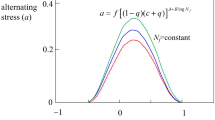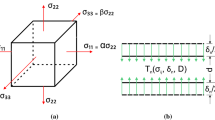Abstract
One of the major failure modes of bioprosthetic heart valves is non-calcific structural deterioration due to fatigue of the tissue leaflets. Experimental methods to characterize tissue fatigue properties are complex and time-consuming. A constitutive fatigue model that could be calibrated by isolated material tests would be ideal for investigating the effects of more complex loading conditions. However, there is a lack of tissue fatigue damage models in the literature. To address these limitations, in this study, a phenomenological constitutive model was developed to describe the stress softening and permanent set effects of tissue subjected to long-term cyclic loading. The model was used to capture characteristic uniaxial fatigue data for glutaraldehyde-treated bovine pericardium and was then implemented into finite element software. The simulated fatigue response agreed well with the experimental data and thus demonstrates feasibility of this approach.
Similar content being viewed by others
References
Alastrué V, Rodríguez JF et al (2007) Structural damage models for fibrous biological soft tissues. Int J Solids Struct 44(18–19): 5894–5911
Broom ND (1978) Fatigue-induced damage in gluteraldehyde-preserved heart valve tissue. J Thorac Cardiovasc Surg 76(2): 202–211
Calvo B, Pena E et al (2007) An uncoupled directional damage model for fibred biological soft tissues. Formulation and computational aspects. Int J Numer Methods Eng 69(10): 2036–2057
Dorfmann A, Ogden RW (2004) A constitutive model for the Mullins effect with permanent set in particle-reinforced rubber. Int J Solids Struct 41(7): 1855–1878
Fung YC (1993) Biomechanics: mechanical properties of living tissues. Springer, New York
Li D, Robertson AM (2009) A structural multi-mechanism damage model for cerebral arterial tissue. J Biomech Eng 131(10): 101013–101018
Miehe C (1995) Discontinuous and continuous damage evolution in Ogden-type large-strain elastic materials. Eur J Mech A Solids 14(5): 697–720
Mirnajafi A, Brett Z et al (2010) Effects of cyclic flexural fatigue on porcine bioprosthetic heart valve heterograft biomaterials. J Biomed Mater Res Part A 94A(1): 205–213
Munt B, Webb J (2006) Percutaneous valve repair and replacement techniques. Heart 92(10):1369–1372 (Epub 2005 Dec 9)
Natali AN, Pavan PG et al (2008) Characterization of soft tissue mechanics with aging. IEEE Eng Med Biol Mag 27(4): 15–22
Pena E (2011) Prediction of the softening and damage effects with permanent set in fibrous biological materials. J Mech Phys Solids 59(9): 1808–1822
Rodríguez JF, Cacho F et al (2006) A stochastic-structurally based three dimensional finite-strain damage model for fibrous soft tissue. J Mech Phys Solids 54(4): 864–886
Sacks MS (2001) The biomechanical effects of fatigue on the porcine bioprosthetic heart valve. J Long-term Eff Med Implant 11(3, 4): 231–247
Schoen FJ, Levy RJ (1999) Tissue heart valves: current challenges and future reserach perspectives. J Biomed Mater Res 47(4): 439–465
Sellaro TL, Hildebrand D et al (2007) Effects of collagen fiber orientation on the response of biologically derived soft tissue biomaterials to cyclic loading. J Biomed Mater Res Part A 80A(1): 194–205
Simo JC (1987) On a fully three-dimensional finite-strain viscoelastic damage model: formulation and computational aspects. Comput Methods Appl Mech Eng 60(2): 153–173
Slaughter WS, Sacks MS (2001) Modeling fatigue damage in chemically treated soft tissues. Funct Biomater 198-1: 255–260
Sun W, Sacks MS (2005) Finite element implementation of a generalized Fung-elastic constitutive model for planar tissues. Biomech Model Mechanobiol 4((2–3): 190–199
Sun W, Sacks M et al (2004) Response of heterograft heart valve biomaterials to moderate cyclic loading. J Biomed Mater Res Part A 69A(4): 658–669
Sun W, Abad A et al (2005a) Simulated bioprosthetic heart valve deformation under quasi-static loading. J Biomech Eng 127(6): 905–914
Sun W, Sacks MS et al (2005b) Effects of boundary conditions on the estimation of the planar biaxial mechanical properties of soft tissues. J Biomech Eng 127(4): 709–715
Sun W, Chaikof E et al (2008) Numerical approximation of tangent moduli for finite element implementations of nonlinear hyperelastic material models. J Biomech Eng 130(6): 20–27
Sun W, Li K et al (2010) Simulated elliptical bioprosthetic valve deformation: implications for asymmetric transcatheter valve deployment. J Biomech 43(16): 3085–3090
Teoh SH (2000) Fatigue of biomaterials: a review. Int J Fatigue 22(10): 825–837
Vyavahare N, Ogle M et al (1999) Mechanisms of bioprosthetic heart valve failure: fatigue causes collagen denaturation and glycosaminoglycan loss. J Biomed Mater Res 46: 44–50
Webb J, Pasupati S et al (2007) Percutaneous transarterial aortic valve replacement in selected high-risk patients with aortic stenosis. Circulation 7(116): 755–763
Zhang XF, Andrieux F et al (2011) Pseudo-elastic description of polymeric foams at finite deformation with stress softening and residual strain effects. Mater Des 32(2): 877–884
Author information
Authors and Affiliations
Corresponding author
Rights and permissions
About this article
Cite this article
Martin, C., Sun, W. Modeling of long-term fatigue damage of soft tissue with stress softening and permanent set effects. Biomech Model Mechanobiol 12, 645–655 (2013). https://doi.org/10.1007/s10237-012-0431-6
Received:
Accepted:
Published:
Issue Date:
DOI: https://doi.org/10.1007/s10237-012-0431-6




